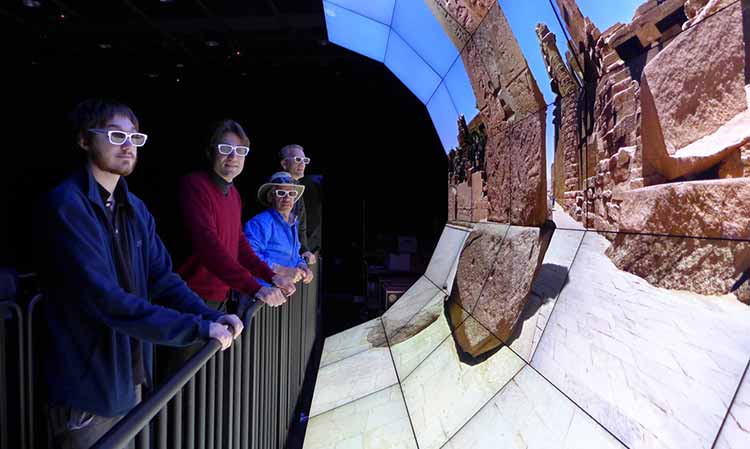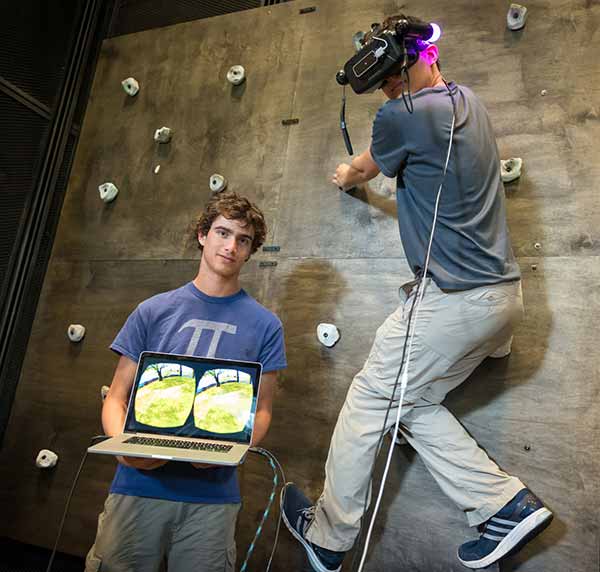UC San Diego Among Multidisciplinary Awards Providing $221M Nationally for Cutting-Edge Projects
Technology & Engineering

VR facilities to be showcased during the Future of Virtual Reality conference include the Wide-Angle Virtual Environment (WAVE) curved wall array of 35 55” commercial LCD monitors
Experts from academia and industry will share their insights into the future of virtual reality technology and content at the first annual Future of Virtual Reality conference. The 2015 event takes place Tuesday and Wednesday, Sept. 8-9, in Atkinson Hall, the headquarters of Calit2’s Qualcomm Institute on the UC San Diego campus.
In addition to the conference, the Future of Virtual Reality will also showcase the latest technologies – from large-scale 3D displays to personalized VR systems such as the Oculus Rift – in a demonstration room next to the conference venue. The latest products and prototypes of VR gear will be on display and demonstrated during breaks in the conference schedule to give attendees an opportunity to interact with and use the newest systems and VR software.
“Most conferences about virtual reality tend to be either focused on the industry, or the more academic side that looks where the technology is going in the medium to long term,” said conference organizer Jurgen Schulze, a research scientist in the Qualcomm Institute. “We decided to merge the two interested audiences, because we see that there is a lot that the two sides can learn from each other – especially when it comes to envisaging how far the technology can take us over the next decade.”
Funding for the Future of Virtual Reality conference is provided, in part, by a grant from the Calit2 Strategic Research Opportunities (CSRO) program of the Qualcomm Institute.

Student researchers in the Qualcomm Institute develop a mini-climbing wall paired with Oculus Rift head-mounted VR display to mimic climbing on archaeological ruins – or Yellowstone park.
The institute is uniquely positioned to be a partner for companies wanting to enter the virtual reality marketplace because of its cutting-edge visualization and virtual reality laboratories, and its world-class research activities in real-time graphics and 3D user interaction. The Qualcomm Institute houses a variety of unique, gold-standard 3D visualization systems, such as the StarCAVE, the NexCAVE, the TourCAVE, and the WAVE, all of which are equipped with 3D tracking systems to allow for the prototyping of immersive VR software applications.
The CSRO grant also provided funds to further develop applications around VR head-mounted displays and see-through augmented-reality displays. Much of the research at UC San Diego in this area involves user control and 3D interaction as researchers develop strategies for how to best run applications on head-mounted consumer displays such as the Oculus Rift and Sony Morpheus.
The sessions planned for the Future of Virtual Reality conference reflect the breadth of open topics in the VR field, including display hardware, panoramic cameras, content generation, spatialized audio, user interaction, social applications of VR, and so on. For university researchers one of the underlying issues is that VR applications can be very hardware dependent because they depend on the existence of specific types of input devices or display devices. Although VR applications are designed at the Qualcomm Institute to run on a variety of graphics cluster-based systems, including the StarCAVE, WAVE and even head-mounted devices such as Oculus Rift, they do not run on mobile devices.
“There are obstacles to deploying our applications on mobile devices, in terms of the operating system, programming language and middleware software,” noted Schulze. “But we believe these obstacles can be overcome so that VR applications can run on the entire range of VR-capable devices, from mobile phones to large, immersive walk-in systems.”
Indeed, Schulze and his colleagues in the Immersive Visualization Laboratory have already created a batch of software applications bringing traditional elements of virtual reality to mobile devices, including a viewer for archaeological dig sites, a 3D sketching tool, and a cell phone-based data viewer that works in conjunction with a large tiled display wall.
The Qualcomm Institute and UC San Diego have earned a reputation for advances in large-scale, virtual reality such as the StarCAVE and WAVE systems. Both were designed to enable multiple collaborators to use the systems to visualize and understand large data sets from a wide variety of disciplines. More recently, the institute has worked on adapting the content created for large-scale systems for use on the Oculus Rift and other personal VR devices.
One of the keynote presentations at the conference will be given by scientist, futurist, author and UC San Diego alumnus David Brin, an acclaimed author of science fiction works that have explored themes of virtual reality. Other speakers at the conference will include academics (Ruth West from the University of North Texas, Sheldon Brown from UC San Diego, and others) as well as industry experts, including Jared Sandrew of Legend 3D, Amir Rubin of Sixense, and Jeffrey Johnson from Aero Glass.
To attend both days of the conference, including the exhibition, registration is $150, including lunches and coffee breaks. To attend only one day, the fee is $100 (lunches and breaks included).
Discount registration is available for students at 50% of the full fee (with valid student ID, use discount code VR2015STUDENT). The same 50% discount is also available for developers with demonstrations; if interested, email request to registration@futureofvr.org.
Demonstrations are still available; if you want to showcase your technology, the first demo desk (including two chairs) is free with any pass, and a second desk (also with two chairs) can be purchased for $100.
Notes: Lunch and afternoon refreshments are only included with full conference passes, but can be purchased separately for $50 per day. All conference attendees, including exhibitors, have access to the lunchtime demonstrations in the CAVE virtual reality environment.
Keep up with all the latest from UC San Diego. Subscribe to the newsletter today.